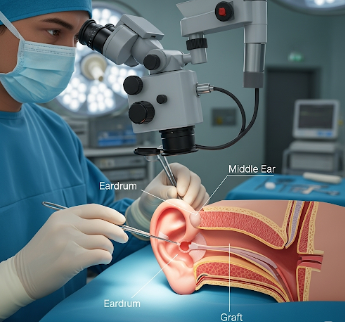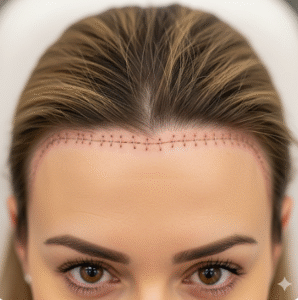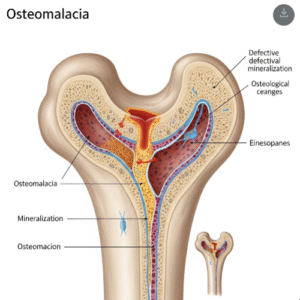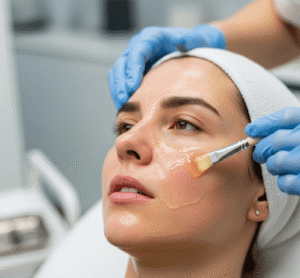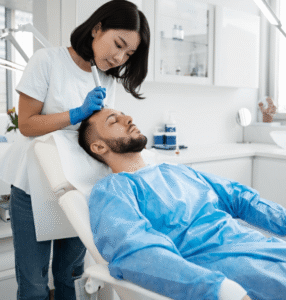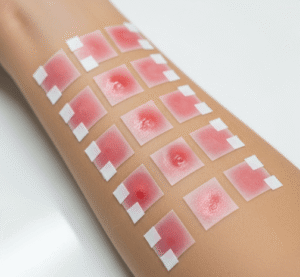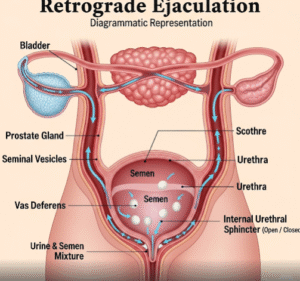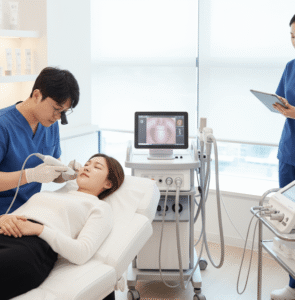Overview
Myringoplasty is a surgical procedure to repair a perforation in the tympanic membrane (eardrum). It is primarily performed to restore hearing, prevent recurrent ear infections, and protect the middle ear from damage.
In Korea, myringoplasty is conducted by experienced ENT surgeons using microscopic and minimally invasive techniques, ensuring precise repair, minimal scarring, and excellent hearing restoration outcomes.
Highlights:
- ✅ Repairs eardrum perforations effectively
- ✅ Improves hearing and prevents recurrent infections
- ✅ Minimally invasive with high success rates
- ✅ Preserves normal ear anatomy and function
What is Myringoplasty?
Myringoplasty involves surgical closure of a hole in the eardrum using the patient’s own tissue (often fascia from the temporalis muscle) or synthetic grafts. It is commonly recommended for:
- Chronic perforations due to infection or trauma
- Hearing loss caused by eardrum defects
- Prevention of repeated middle ear infections
- Complications following previous ear surgeries
Important: Myringoplasty focuses only on the eardrum, unlike tympanoplasty, which may involve reconstruction of the middle ear bones.
What are the benefits?
- Hearing improvement: Restores sound conduction through the repaired eardrum
- Infection prevention: Seals the perforation to reduce recurrent otitis media
- Preservation of ear structure: Maintains normal middle ear anatomy
- Minimal scarring: Small incisions and microscopic techniques improve cosmetic outcomes
Key benefits highlighted:
- ⚡ High success rate in adults and children
- ⚡ Rapid recovery with minimally invasive techniques
- ⚡ Reduces need for repeated ear infections or surgeries
- ⚡ Improves overall quality of life by restoring hearing
Procedure Details
1) How should I prepare for Myringoplasty?
- Preoperative evaluation: Ear examination, audiometry, and imaging if necessary
- Medication review: Discontinue blood thinners or medications as instructed
- Fasting: Required if general anesthesia is planned
- Consent and counseling: Discuss procedure, expected outcomes, risks, and postoperative care
- Lifestyle preparation: Arrange for postoperative rest and avoid swimming or water exposure until healed
2) What happens during Myringoplasty?
- Anesthesia: Local or general anesthesia administered
- Incision and graft preparation: Tissue harvested from temporalis fascia or other donor site
- Eardrum repair: Perforation edges refreshed, and graft placed to close the hole
- Closure: Graft secured, and ear packed with absorbable material
Duration: Typically 1–2 hours depending on perforation size and complexity
3) What happens after Myringoplasty?
- Recovery monitoring: Observation for bleeding, infection, and graft position
- Pain management: Mild analgesics prescribed
- Activity: Avoid water entry into the ear, strenuous activity, and nose blowing for several weeks
- Follow-up care: Audiometry and examination to assess graft success and healing
Highlights for post-procedure care:
- ⚡ Mild discomfort, dizziness, or muffled hearing is normal
- ⚡ Ear packing removed after 1–2 weeks
- ⚡ Keep ear dry until complete healing
- ⚡ Attend all follow-up visits to ensure graft success and hearing restoration
Risks / Benefits
Risks:
- Infection at the surgical site
- Graft failure or partial closure of the perforation
- Hearing not fully restored in all cases
- Rare complications such as dizziness or tinnitus
Benefits:
- Effective closure of eardrum perforation
- Restores hearing and prevents recurrent infections
- Minimally invasive with low complication rates
- Preserves normal ear anatomy and function
Recovery and Outlook
- Hospital stay: Usually outpatient; same-day discharge possible
- Full recovery: 3–6 weeks for complete healing; hearing improvement may continue over several months
- Long-term outlook: Excellent; most patients regain normal hearing and have a permanently repaired eardrum
- Follow-up: Regular ENT visits to monitor graft healing and hearing
Tips for optimal recovery:
- ✅ Keep ear dry and avoid swimming for at least 6 weeks
- ✅ Avoid nose blowing or inserting objects into the ear
- ✅ Attend all follow-up appointments for audiometric assessment
- ✅ Monitor for signs of infection such as pain, discharge, or fever
When To Call the Doctor
- Fever, chills, or signs of infection
- Persistent or severe ear pain
- Bleeding or discharge from the operated ear
- Hearing not improving or worsening
- Dizziness or balance issues
Best Korea Option / Process
Korea provides advanced Myringoplasty care:
- Top hospitals: Specialized ENT centers with expert surgeons
- Minimally invasive techniques: Microscopic repair ensures precise graft placement
- Advanced diagnostics: Audiometry, tympanometry, and imaging for accurate planning
- Postoperative care: Pain management, graft monitoring, and follow-up hearing tests
- International patient support: Online consultations, appointment scheduling, and telemedicine follow-up
Step-by-step process in Korea:
- Preoperative consultation and ear evaluation
- Surgical planning with graft selection
- Myringoplasty performed under local or general anesthesia
- Postoperative monitoring and ear care instructions
- Follow-up appointments to assess healing and hearing restoration

